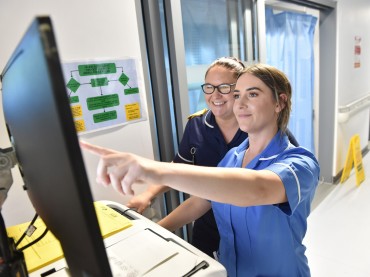This leaflet contains important information about your procedure. Please take the time to read it prior to your appointment.
What is Indocyanine Green Angiography?
It is a diagnostic procedure that provides a detailed view of the blood vessels at the back of your eye, through scans. This will guide the doctors in both diagnosing and deciding on the best treatment for your condition.
Indocyanine Green is a medical dye, which when administered through the cannula (a small tube), circulates through the two layers at the back of the eye (Retina and Choroid). Several Scans are taken before, during and after the infusion to outline any abnormalities that may be present, as the dye passes through the vessels.
Your admission and scan session takes approximately 40 minutes. Once completed you will be given a drink before you are discharged.
It is important to remain still for the procedure, as we need to capture the scans as the dye passes through. It is not possible to repeat these scans on the same day. The nursing team will ensure you are comfortable prior to infusing the dye.
Once your pupils are dilated you will sit in front of a retinal camera for the scans.
The photography session takes approximately 10 minutes. Once this has been completed you will be asked to remain in the department until you are discharged.
You are under no obligation to have the procedure, if you decide not to proceed with the diagnostic test; your doctor will talk through available options.
The procedure is carried out on the Medical Retina Unit, located in Area 5 on the main corridor at Blackpool Victoria Hospital.
A nurse will ask several questions with regards to your health and medications. Your blood pressure, and where relevant, your blood sugar reading will be recorded. If you are currently taking warfarin, please ensure your bring your yellow INR book to this appointment, the nurse will need to record your most recent INR result and your target range.
It is important to inform the nurse of any allergies you may have or if you are pregnant or breast-feeding. It is important if you have an allergy to iodine, sodium iodide or shellfish, that you contact the unit before your appointment as you may be unable to have Indocyanine Green Angiography.
Drops will be administered into one or both eyes to dilate the pupil/s to enable the scans to be taken. It takes approximately 20-30 minutes for the drops to take effect. As these drops will make your vision blurred for 6-8 hours it is not advisable to drive yourself to your appointment, as you will not be able to drive until the dilating drops have worn off.
Indocyanine Green dye is given intravenously therefore a nurse will insert a cannula (small tube) into a suitable vein in the back of your hand or arm prior to the procedure. This cannula will remain in place until after the procedure and will be removed prior to discharge.
The images will be sent to your consultant who will review the results. If you do not already have an appointment, an appointment will be sent out in the post to attend either the Medical Retina Unit or Pink Reception Eye Clinic.
Indocyanine Green Angiography is generally a safe procedure, fewer than 1 in 10,000 patients have reported side effects. Most patients feel no ill effects following the procedure with the exception of blurred vision and occasionally a dazzled sensation from the camera flash.
This procedure requires your formal consent.
This booklet has been written to enable you to make an informed decision in relation to agreeing to the investigation.
The consent form is a legal document, therefore please read this information booklet and the consent form carefully. Once you have read and understood all the information including the possibility of complication and you agree to undergo the investigation, the nurse will ask you sign and date the consent form.
REMEMBER TO BRING THE BOOKLET WITH YOU TO YOUR APPOINTMENT.
If there is anything you do not understand or wish to discuss further please contact the department on the contact numbers given on your admission letter.
Occasionally the dye may leak out of your vein into the surrounding tissue causing pain, the nurses are trained to care for you in the event of this occurring, and if required seek medical help.
A small number of patients feel nauseous when the dye is injected. This usually passes very quickly; it is rare for patients to vomit.
Rarely patients can develop an allergic reaction to the drug, it can be a mild, moderate or severe reaction. If you do experience side effects the nurses are trained to care for you until you are well.
Itching of the skin or a rash may occur but again this is rare.
Some patients have noted a numbness of the tongue and lips that passes, if this does occur please inform a nurse.
Rarely patients develop a severe reaction called anaphylaxis; this can cause the tongue and face to swell and breathing difficulties. If this does happen the nurses on the unit will give you the required care.
• On the day of your procedure please take all medications as you normally would. You can also eat and drink as normal.
• Please bring a list of your current medication.
• If you take warfarin please bring your yellow INR book.
• Your eyes will be dilated therefore you will be unable to drive home.
• You will be given the opportunity to ask questions on the day of the procedure.
• Please bring any heart or chest inhalers you are prescribed.
• Please bring with you any glasses that you wear.
• If you are a contact lens wearer it may be advisable to not wear them to your appointment.
• If you are unable to attend the appointment please contact the unit, so the appointment can be offered to another patient.
If you have any questions to ask, please feel free to write them down.
Author Nicky Kirky
Leaflet Number PL/1327 (V2)
Review Date 01/04/2027



